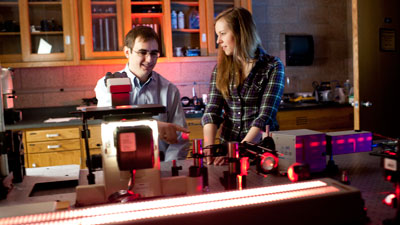Oct 28 2013
Assistant Professor of Physics Nathan Lindquist has been awarded a $252,393 grant from the National Science Foundation (NSF) for his project, “Super-resolution plasmon-enhanced imaging and spectroscopy with patterned metallic surfaces and dynamic illumination.”
 Assistant Professor of Physics Nathan Lindquist works with a student in Bethel's NanoLab.
Assistant Professor of Physics Nathan Lindquist works with a student in Bethel's NanoLab.
“We want our microscope to take chemical images so – instead of just identifying what something ‘looks like’ – we can identify what it is made of, too,” explains Lindquist. “There are several ways to do this, but we are mostly interested in taking chemical images of surfaces, like cell membranes.” In graduate school at the University of Minnesota, Lindquist studied the peculiar form of light waves that allow precise imaging of surfaces. These light waves, called plasmons, are stuck to surfaces, he explains. “To get these plasmons, the surfaces have to be nano-thin or decorated with nano patterns. Since we can make these nano-surfaces here at Bethel, thanks to some new equipment to furnish a little cleanroom, we will also be using this grant to explore better and cheaper ways for nanofabrication.” Bethel’s new “NanoLab” and cleanroom allow students to work in a contamination-free environment as they work with these tiny nano devices.
The NSF grant will support the development of new microscope imaging techniques to do just that. Such advanced research at a school like Bethel is unique, because there are no graduate students anchoring research initiatives. Instead, undergraduate students have gotten the unique opportunity to engage in this cutting-edge research in the field of nanotechnology and imaging.
According to Lindquist, undergraduates have in fact been integral to the development of this program. From the design process for the new microscope, to research integrated into existing coursework and senior and summer projects, the program has already allowed collaboration between students and faculty members like Lindquist. But now, he says, this grant will specifically fund undergraduate nano research projects for the next three years.
The grant is awarded through the Research in Undergraduate Institutions (RUI) program of NSF, which supports research programs and instrumentation at institutions that have a majority undergraduate enrollment. Additional funding for this project has come from Bethel internally and a Bethel Alumni Faculty Grant during the 2012-2013 academic year. “This support helped lay the groundwork to get the preliminary results necessary for a good grant proposal,” explains Lindquist. “I also need to acknowledge our physics department as a whole. Without its great labs, my great colleagues, and our great students, this sort of research would be pretty difficult.”
Lindquist is the third Bethel physics professor to be awarded an NSF grant in the last year, and the grants have totaled more than $625,000. "The three NSF grants currently being awarded to physics principal investigators represent an extraordinary achievement in the current funding climate in Washington and the hyper-intense and bitterly competitive peer reviewing process that results,” explains Dick Peterson, university professor of physics emeritus, who had a two-year appointment to NSF as a program director. “Going 3 for 3 for a small STEM (Science, Technology, Engineering and Mathematics) department must be unique in the U.S."